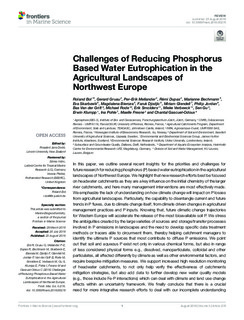| dc.contributor.author | Bol, Roland | |
| dc.contributor.author | Gruau, Gerard | |
| dc.contributor.author | Mellander, Per-Erik | |
| dc.contributor.author | Dupas, Remi | |
| dc.contributor.author | Bechmann, Marianne | |
| dc.contributor.author | Skarbøvik, Eva | |
| dc.contributor.author | Bieroza, Magdalena | |
| dc.contributor.author | Djodjic, Faruk | |
| dc.contributor.author | Glendell, Miriam | |
| dc.contributor.author | Jordan, Philip | |
| dc.contributor.author | van der Grift, Bas | |
| dc.contributor.author | Rode, Michael | |
| dc.contributor.author | Smolders, Erik | |
| dc.contributor.author | Verbeeck, Mieke | |
| dc.contributor.author | Gu, Sen | |
| dc.contributor.author | Klumpp, Erwin | |
| dc.contributor.author | Pohle, Ina | |
| dc.contributor.author | Fresne, Maelle | |
| dc.contributor.author | Gascuel-Odoux, Chantal | |
| dc.date.accessioned | 2018-11-14T12:17:53Z | |
| dc.date.available | 2018-11-14T12:17:53Z | |
| dc.date.created | 2018-10-01T09:21:52Z | |
| dc.date.issued | 2018-08-23 | |
| dc.identifier.citation | Frontiers in Marine Science. 2018, 5 1-16. | nb_NO |
| dc.identifier.issn | 2296-7745 | |
| dc.identifier.uri | http://hdl.handle.net/11250/2572826 | |
| dc.description.abstract | In this paper, we outline several recent insights for the priorities and challenges for future research for reducing phosphorus (P) based water eutrophication in the agricultural landscapes of Northwest Europe.We highlight that new research efforts best be focused on headwater catchments as they are a key influence on the initial chemistry of the larger river catchments, and here many management interventions are most effectively made. We emphasize the lack of understanding on how climate change will impact on P losses from agricultural landscapes. Particularly, the capability to disentangle current and future trends in P fluxes, due to climate change itself, from climate driven changes in agricultural management practices and P inputs. Knowing that, future climatic change trajectories for Western Europe will accelerate the release of the most bioavailable soil P. We stress the ambiguities created by the large varieties of sources and storage/transfer processes involved in P emissions in landscapes and the need to develop specific data treatment methods or tracers able to circumvent them, thereby helping catchment managers to identify the ultimate P sources that most contribute to diffuse P emissions. We point out that soil and aqueous P exist not only in various chemical forms, but also in range of less considered physical forms e.g., dissolved, nanoparticulate, colloidal and other particulates, all affected differently by climate as well as other environmental factors, and require bespoke mitigation measures. We support increased high resolution monitoring of headwater catchments, to not only help verify the effectiveness of catchments mitigation strategies, but also add data to further develop new water quality models (e.g., those include Fe-P interactions) which can deal with climate and land use change effects within an uncertainty framework. We finally conclude that there is a crucial need for more integrative research efforts to deal with our incomplete understanding of the mechanisms and processes associated with the identification of critical source areas, P mobilization, delivery and biogeochemical processing, as otherwise even highintensity and high-resolution research efforts will only reveal an incomplete picture of the full global impact of the terrestrial derived P on downstream aquatic and marine ecosystems. | nb_NO |
| dc.language.iso | eng | nb_NO |
| dc.rights | Navngivelse 4.0 Internasjonal | * |
| dc.rights.uri | http://creativecommons.org/licenses/by/4.0/deed.no | * |
| dc.subject | Phosphorus | nb_NO |
| dc.subject | Cycling | nb_NO |
| dc.subject | Soil | nb_NO |
| dc.subject | Eutrophication | nb_NO |
| dc.subject | Climate change | nb_NO |
| dc.subject | Colloidal and Particulate | nb_NO |
| dc.subject | Water quality | nb_NO |
| dc.title | Challenges of Reducing Phosphorus Based Water Eutrophication in the Agricultural Landscapes of Northwest Europe | nb_NO |
| dc.type | Journal article | nb_NO |
| dc.type | Peer reviewed | nb_NO |
| dc.description.version | publishedVersion | nb_NO |
| dc.rights.holder | Copyright © 2018 Bol, Gruau, Mellander, Dupas, Bechmann, Skarbøvik, Bieroza, Djodjic, Glendell, Jordan, Van der Grift, Rode, Smolders, Verbeeck, Gu, Klumpp, Pohle, Fresne and Gascuel-Odoux. | nb_NO |
| dc.subject.nsi | VDP::Landbruks- og Fiskerifag: 900::Landbruksfag: 910::Jordfag: 913 | nb_NO |
| dc.subject.nsi | VDP::Landbruks- og Fiskerifag: 900 | nb_NO |
| dc.subject.nsi | VDP::Landbruks- og Fiskerifag: 900::Landbruksfag: 910::Naturressursforvaltning: 914 | nb_NO |
| dc.source.pagenumber | 1-16 | nb_NO |
| dc.source.volume | 5 | nb_NO |
| dc.source.journal | Frontiers in Marine Science | nb_NO |
| dc.identifier.doi | 10.3389/fmars.2018.00276 | |
| dc.identifier.cristin | 1616472 | |
| cristin.ispublished | true | |
| cristin.fulltext | original | |
| cristin.qualitycode | 1 | |

